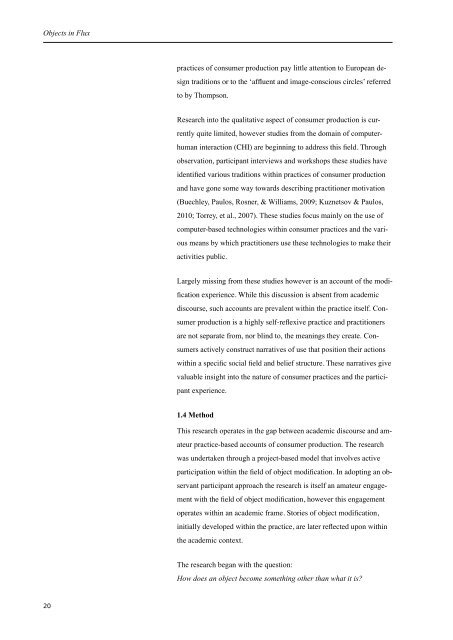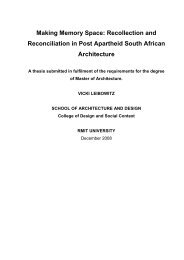Objects in Flux - RMIT Research Repository - RMIT University
Objects in Flux - RMIT Research Repository - RMIT University
Objects in Flux - RMIT Research Repository - RMIT University
You also want an ePaper? Increase the reach of your titles
YUMPU automatically turns print PDFs into web optimized ePapers that Google loves.
<strong>Objects</strong> <strong>in</strong> <strong>Flux</strong><br />
20<br />
practices of consumer production pay little attention to European design<br />
traditions or to the ‘affluent and image-conscious circles’ referred<br />
to by Thompson.<br />
<strong>Research</strong> <strong>in</strong>to the qualitative aspect of consumer production is currently<br />
quite limited, however studies from the doma<strong>in</strong> of computerhuman<br />
<strong>in</strong>teraction (CHI) are beg<strong>in</strong>n<strong>in</strong>g to address this field. Through<br />
observation, participant <strong>in</strong>terviews and workshops these studies have<br />
identified various traditions with<strong>in</strong> practices of consumer production<br />
and have gone some way towards describ<strong>in</strong>g practitioner motivation<br />
(Buechley, Paulos, Rosner, & Williams, 2009; Kuznetsov & Paulos,<br />
2010; Torrey, et al., 2007). These studies focus ma<strong>in</strong>ly on the use of<br />
computer-based technologies with<strong>in</strong> consumer practices and the various<br />
means by which practitioners use these technologies to make their<br />
activities public.<br />
Largely miss<strong>in</strong>g from these studies however is an account of the modification<br />
experience. While this discussion is absent from academic<br />
discourse, such accounts are prevalent with<strong>in</strong> the practice itself. Consumer<br />
production is a highly self-reflexive practice and practitioners<br />
are not separate from, nor bl<strong>in</strong>d to, the mean<strong>in</strong>gs they create. Consumers<br />
actively construct narratives of use that position their actions<br />
with<strong>in</strong> a specific social field and belief structure. These narratives give<br />
valuable <strong>in</strong>sight <strong>in</strong>to the nature of consumer practices and the participant<br />
experience.<br />
1.4 Method<br />
This research operates <strong>in</strong> the gap between academic discourse and amateur<br />
practice-based accounts of consumer production. The research<br />
was undertaken through a project-based model that <strong>in</strong>volves active<br />
participation with<strong>in</strong> the field of object modification. In adopt<strong>in</strong>g an observant<br />
participant approach the research is itself an amateur engagement<br />
with the field of object modification, however this engagement<br />
operates with<strong>in</strong> an academic frame. Stories of object modification,<br />
<strong>in</strong>itially developed with<strong>in</strong> the practice, are later reflected upon with<strong>in</strong><br />
the academic context.<br />
The research began with the question:<br />
How does an object become someth<strong>in</strong>g other than what it is?
















